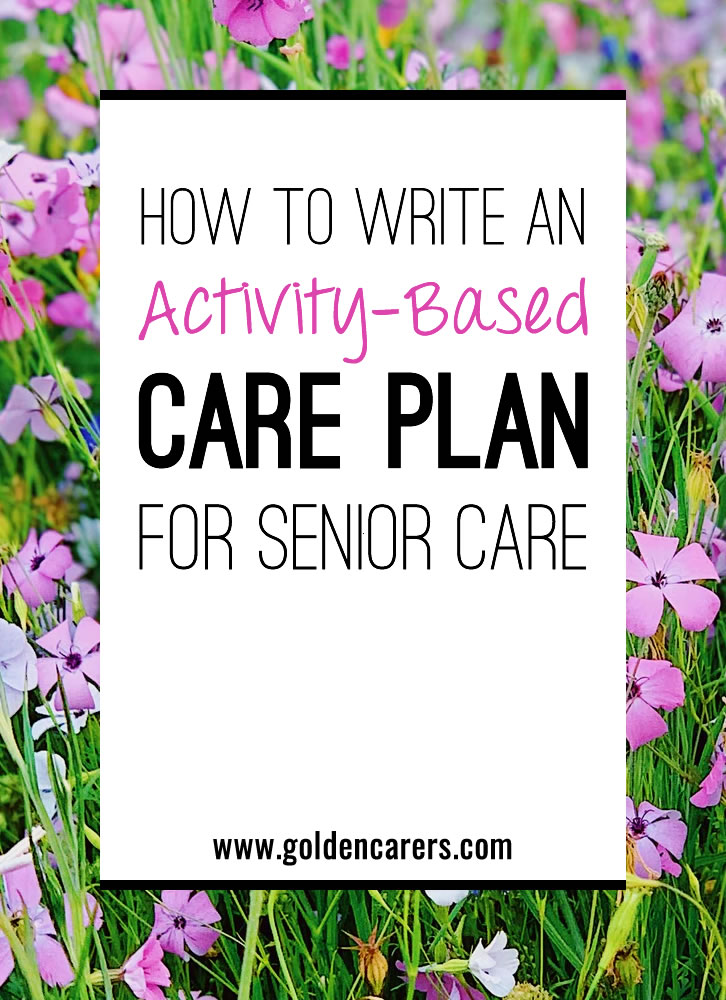
Related Activities
Comments Post a Comment
Jeanne  21st Oct 2022
Activities Director
21st Oct 2022
Activities Director
 21st Oct 2022
Activities Director
21st Oct 2022
Activities Director
I am an activity director at a SNL. I would like to know how to write a care plan for a resident who is going to be volunteering in our administration offices.
Maritza Jimenez
17th Oct 2022
Hello I'm very new to the activity director community and would like to understand a little more about how to complete a care plan
gladyz  25th Sep 2018
Recreational Activities
25th Sep 2018
Recreational Activities
 25th Sep 2018
Recreational Activities
25th Sep 2018
Recreational Activities
Hi thanks for your help, I would like if you can help me how to write about sensory, sensitive,cognitive and some examples please. Thanks gladyz
Talita  30th Sep 2018
30th Sep 2018
 30th Sep 2018
30th Sep 2018
Hi Gladyz,
There are a few care plan samples available here:
https://www.goldencarers.com/care-plans/
Hopefully this helps!
There are a few care plan samples available here:
https://www.goldencarers.com/care-plans/
Hopefully this helps!
Norma Jean  20th Aug 2018
Activities Director
20th Aug 2018
Activities Director
 20th Aug 2018
Activities Director
20th Aug 2018
Activities Director
It's been many years since Ive worked in this field. This website has been my weekly go to for activities and calendar planning. I'm about to try the reports part of the site. I'm thrilled so far and appreciate all of you who share.
Talita  26th Aug 2018
26th Aug 2018
 26th Aug 2018
26th Aug 2018
Thank you so much for your feedback Norma Jean, we appreciate it so much!
Ngoc  11th Jan 2018
lifestyle student
11th Jan 2018
lifestyle student
 11th Jan 2018
lifestyle student
11th Jan 2018
lifestyle student
I am so happy to come back with Golden carers , my job will be struggling without you
I feel like blessing to get to know this wonderful website
Thank you very much Golden carers,
Hope you all have a wonderful and successful new year.
I feel like blessing to get to know this wonderful website
Thank you very much Golden carers,
Hope you all have a wonderful and successful new year.
Talita  14th Jan 2018
14th Jan 2018
 14th Jan 2018
14th Jan 2018
Thank you so much Ngoc, wishing a wonderful year too! All the best!
dorothy  28th Jul 2016
diversional therapist
28th Jul 2016
diversional therapist
 28th Jul 2016
diversional therapist
28th Jul 2016
diversional therapist
don't forget the emotional , Cultural and spiritual care plan
Marija  9th May 2014
Recreation Therapist
9th May 2014
Recreation Therapist
 9th May 2014
Recreation Therapist
9th May 2014
Recreation Therapist
Us beginners in our work, paperwork is the most difficult part of the job. Your advice and example helps a lot. Thanks a lot!!
Marija
Marija
Michelle  19th Feb 2014
Recreation Activities Officer
19th Feb 2014
Recreation Activities Officer
 19th Feb 2014
Recreation Activities Officer
19th Feb 2014
Recreation Activities Officer
Agree with Maryann, remember the care plan and program must include choices to allow person centred care. Not what the Lifestyle/Activities Team are good at doing or enjoy.
MARYANN  18th Feb 2014
Diversional Therapist/Lifestyle Manager
18th Feb 2014
Diversional Therapist/Lifestyle Manager
 18th Feb 2014
Diversional Therapist/Lifestyle Manager
18th Feb 2014
Diversional Therapist/Lifestyle Manager
As a Qualified D.T. can l say congratulation the information you are providing is fantastic - just a reminder to all - LOOK OUTSIDE THE SQUARE but always remember the PERSON - CENTRE PRESON CARE. (Ask the person)
We sometimes forget Community Social Interaction in our programs
We sometimes forget Community Social Interaction in our programs


 Enhancing the Senior Living Experience with Pets
Enhancing the Senior Living Experience with Pets
 12 Tips for Writing Progress Notes
12 Tips for Writing Progress Notes
 Checklist for Social Outings
Checklist for Social Outings
 Resistive Behaviour Care Plan Sample
Resistive Behaviour Care Plan Sample

